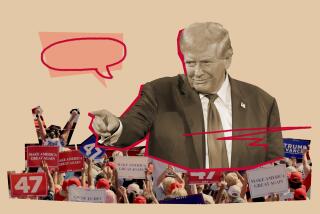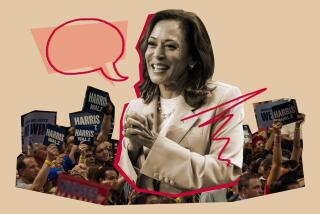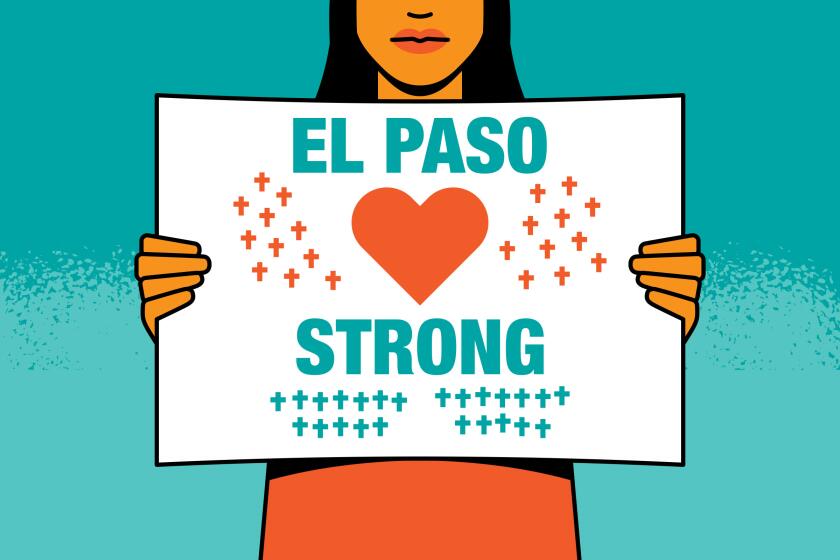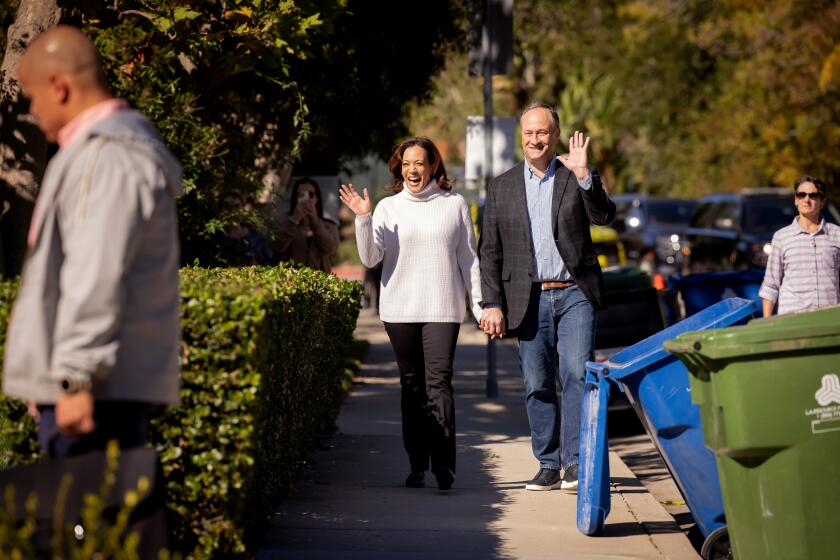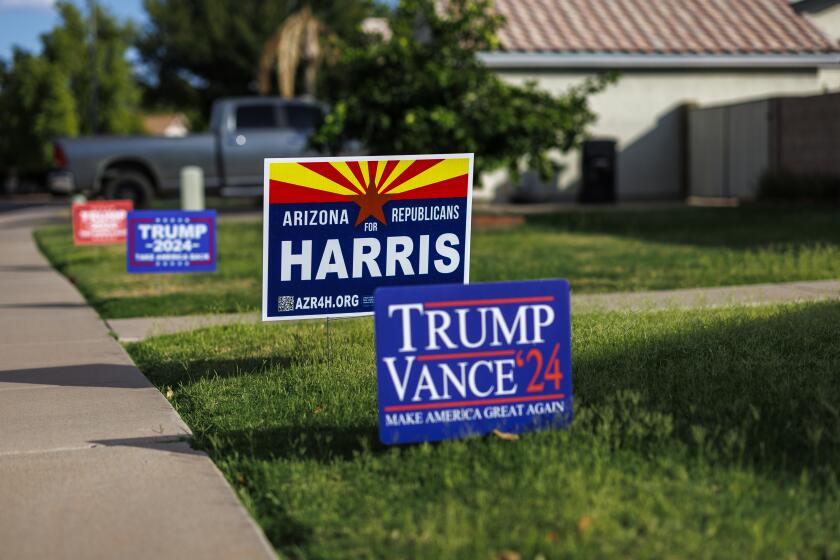Politics and the Media : Television: Candidates’ ‘Mine Field’
“Television is a medium that encourages a certain sense of appealing sterility,” says Albert Hunt, Washington bureau chief of the Wall Street Journal.
“Television . . . gives added importance to the sort of easygoing, relaxed, stable, calm . . . personality,” says political consultant Douglas Bailey.
Television is “far and away” the most important factor in a political campaign, says former Sen. Gary Hart, unsuccessful Democratic candidate for President.
Why is television all-powerful? The success of President Reagan notwithstanding, it’s not just that some candidates are more telegenic than others. After all, both RichardM. Nixon and Jimmy Carter were largely ineffective on television, and both won the presidency.
In fact, reporter Sidney Blumenthal of the Washington Post argues that Vice President George Bush may be “the most tele-repellent candidate ever,” and other critics have joked that Bush is so inarticulate he may be the first presidential candidate whose television appearances raise the question of whether English is his second language. Yet he is about to become the Republican Party’s presidential nominee.
Massachusetts Gov. Michael S. Dukakis, widely derided as boring on television before his speech accepting the Democratic presidential nomination last month, was in a position to give that speech because he, like Bush, this year won a contested campaign for the presidency against candidates whom the camera seemed to love far more than him.
But television is important because it “creates a gauntlet for the candidates to run through,” says S. Robert Lichter, co-director of the Center for Media and Public Affairs, who is studying the impact of television on political campaigns.
Prolonged Exposure
Although there are many factors to be considered in any discussion of the changing role of the press in the political process, it is television, Lichter says, that forces candidates to “be on stage for lengthy periods of time. . . . It creates a mine field you have to step through, and one wrong step and you blow up, you’re gone.”
That, Lichter says, makes it “more difficult for bold, dynamic, noncentrist candidates.”
Print reporters implicitly judge and help to temper messages from such candidates, if only by their method of conveying the message--indirectly, on paper. But television viewers can see and judge the candidates and their messages for themselves, without intermediaries. That is why candidates build their campaign schedules around television appearances--so they can appeal directly to the voters.
But television--as Marshall McLuhan wrote--is a “cool medium.” Many “hot” candidates--bold, aggressive, charismatic, strongly partisan, risk-taking candidates--just don’t wear well with television viewers in the course of our ever longer and more heavily covered political campaigns.
“The by-product of intense TV scrutiny is to weed out extremes,” says Marvin Kalb, longtime NBC diplomatic correspondent and now director of the Joan Shorenstein Barone Center on the Press, Politics and Public Policy at Harvard University. “If you look at people over and over again on the tube, you will . . . (have) an homogenized product.”
Ironically, the political reforms of the late 1960s and 1970s might have been expected to produce more, rather than less charismatic candidates. The reforms were designed, after all, to shift power away from the more conservative, status-quo forces--the political parties and the rest of the Establishment--to “the people,” the individual voters, and thereby give a greater role to minorities, women and others long shut out of the process.
“The shift from the back room to the direct primary favors candidates who are more dynamic . . .farther from the center, because those are the kinds of candidates that primary voters are more likely to favor. . . .” Lichter says. “Party activists . . . tend to be more susceptible to charismatic appeal and (to be) more ideological than the typical voter. . . .”
But the primaries also give the media--especially television--more power. Television cameras couldn’t go into the back rooms; they can go on the campaign trail.
That “creates a conflict for such (charismatic, ideological) candidates,” Lichter says, “because the message that they use to reach the party activists is necessarily different than the message they need to reach out to the great mass of voters who are closer to the center.
“Television,” Lichter says, “makes it possible for someone like Jesse Jackson to break out of the pack and become a national figure, but it makes it harder for Jackson to actually become the nominee.”
Or, as Jeff Greenfield, political and media analyst for ABC, puts it:
“Jesse Jackson’s success is built primarily on the ground that he is jambalaya and everybody else is mush”--and, in the long run, most Americans seem to prefer mush to jambalaya.
“America gets bad presidents because it gets bad candidates, and it gets bad candidates because they are now chosen chiefly in a series of primary elections in which voters put a premium on superficial qualities televisually conveyed, with little consideration of the attributes needed to run the most powerful country in the world,” The Economist of London has said.
It is probably true that, as David Shribman, political reporter for the Wall Street Journal, says: “If you stink on TV, you’re not going to be President of the United States.” Television, Shribman says, has the only “veto” power in contemporary politics; print reporters are “reminded every day of their diminishing importance.”
Press Sets Agenda
Nevertheless, the major publications still set the agenda--for television and, indirectly, for society.
“I can tell you what days my phone is going to ring off the hook . . . based on what’s in print,” says political consultant Peter Hart. “If there’s an interesting and important subject and I have a quote in the paper . . . in the New York Times, the Wall Street Journal, the Washington Post . . . I know that I will see a camera crew some time during that day. It is rare that the reverse happens, where I will be interviewed by a television network and the next day I will get calls from the printed press.”
It was a newspaper--the Miami Herald--that published the story on former Sen. Gary Hart and model Donna Rice that led to Hart’s first withdrawal from the Democratic presidential campaign last year, and it was another newspaper story--in the New York Times and the Des Moines Register--that first disclosed Delaware Sen. Joseph R. Biden Jr.’s unattributed appropriation of the language and life story of British Labor Party leader Neil Kinnock.
The better reporters for the better newspapers and magazines have more time to report and present their stories than do their television counterparts, so the print press generally provides more investigative stories and more in-depth articles on various aspects of the candidates and the campaign. Television coverage, by contrast, remains--with a few exceptions--little more than a headline service. A 1985 study found that the average TV “sound bite” (interview segment) lasted 11 seconds; a 1988 study by the Center for Media and Public Affairs found that the average network campaign report during this election has run less than two minutes.
Television has an “indelible” impact, though, Peter Hart says. The Biden-Kinnock story would not have had the impact in the print press that it had on television, he says. “It was (seeing and hearing) the haunting words (of Biden and Kinnock) played side by side” that proved so devastating to Biden.
Biden was devastated again when C-SPAN aired a film clip of him responding nastily to a question from a New Hampshire voter and lying several times about his law school record.
Many critics say the press unfairly knocked both Biden and Gary Hart out of the race--before voters could go to the polls--with their “sensationalized” coverage of the controversies.
But both Susan Estrich, campaign manager for Dukakis, and Stephen Hess, senior fellow in government studies at the Brookings Institution--among many others--argue that in those two cases the press didn’t raise new concerns, it just reported events that helped crystallize existing concerns about those two candidates in the voters’ minds.
“In all the campaigns that I’ve covered now, which goes back more than 20 years, one thing I’m sure of,” says Martin Nolan, editorial page editor of the Boston Globe. “It is not the aberrations of character that defeat politicians. It’s the . . . episode that reveals the character--George Romney saying he was ‘brainwashed’ (about Vietnam) . . . Jerry Ford ‘liberating’ Poland by mistake (during a televised debate with Jimmy Carter) . . . Gary Hart doing something reckless and ill-thought-out . . . .”
No, most people interviewed for this story said, the press did not “get” Biden or Hart. Biden and Hart “got” themselves.
The stories on Hart and Biden did, however, demonstrate the impact of the press in several other ways--most notably, its impact very early in the political process, when only the candidates and the press seem to care about the contest.
In earlier years, candidates had the luxury of “out-of-town” tryouts--the equivalent of “grapefruit league” exhibition games in baseball--to test ideas and tactics, to polish speeches and smooth the rough edges off personalities before the campaign reached Broadway, Opening Day--the major primaries and the two national conventions. Today, the grapefruit league has become a banana peel; virtually everything a candidate says or does, from his first visit to an early-primary state on, is recorded by some reporter or another, and if he slips he may be doomed.
Biden’s damaging confrontation with a New Hampshire voter, for example, didn’t occur in a candidates’ public forum a week before the New Hampshire primary. It occurred in someone’s living room 10 months before the primary. But it was recorded by C-SPAN and resurrected later in the campaign. Bye-bye, Biden.
Presidential campaigns--and presidential campaign coverage--now start earlier and earlier. How early? Paul West, political reporter for the Baltimore Sun, says he received a call last month from a U.S. senator, a Republican not running for President this year, who wanted West’s home telephone number. Why?
“Everyone knows he’s on the short list for 1992 if Bush loses this year,” West says.
Most people interviewed for this story agreed that the press not only has its greatest impact but also tends to do much of its best, most substantive work in the very early stages of a presidential campaign. Thus, the press offers voters the most help when they least need it and the least help when they most need it.
The press provides many thoughtful analyses on the process and detailed profiles of the candidates months before the first primaries. Then, many interviewees said, when it is time for the public to vote, reporters have become jaded and bored by hearing the same speeches over and over, day after day, month after month, and they forget that most voters weren’t paying attention to what they wrote and said earlier. Unwittingly, perhaps, they convey their boredom to the electorate--sometimes by saying how boring the candidates themselves are.
The early glut of press coverage was greater than ever this year. CNN and C-SPAN joined the networks, wire services and major metropolitan newspapers on the campaign trail, and many smaller newspapers covered the 1988 presidential primaries for the first time. So did a number of local television stations, by taking advantage of new satellite technology.
There were almost 3,000 reporters in Iowa for the first caucuses of the primary season, and on the Friday before those caucuses, the Des Moines Register published a large, Page 1 photo of Dukakis in downtown Des Moines surrounded by so many reporters and cameras--”a boiling, moving mass,” the paper called it--that if he “happened to encounter an actual Iowa voter . . . it was purely an accident.”
The very presence of so many reporters that early in the campaign almost inevitably skews press coverage, campaign priorities and voter perceptions.
Gerald Austin, campaign manager for the Rev. Jesse Jackson, said in a forum in Boston in June that another factor in this year’s campaign was the presence of “an incredible amount of rookies on the press plane (who were) . . . totally unknowledgeable about what was going on.”
With some notable exceptions, many of these younger reporters “did not have either the experience or the security to go out on a limb and challenge the prevailing wisdom,” says John Buckley, press spokesman for New York Rep. Jack Kemp’s presidential campaign and now a political consultant to CBS News.
Result?
“The conventional wisdom became more conventional and less wise,” Buckley says.
But the length of the 1988 campaign and the large number of candidates in the early going forced the networks and most newspapers trying to cover several candidates to use reporters who had not previously covered campaigns. At the increasingly cost-consciousness networks, young researchers and off-camera reporters, rather than more experienced correspondents, followed the candidates most of the time and reported to correspondents and executives who coordinated their reports in New York and Washington.
Marty Plissner, executive political director for CBS, says this approach actually enabled CBS to provide more efficient, cohesive coverage, and Stephen Hess of the Brookings Institution says some network coverage may indeed have been better during the 1988 primaries, if only “by accident.”
Before this year, networks sent their star correspondents on the campaign trail and then felt obligated to put them on the air even if the candidates they were covering had neither said nor done anything newsworthy that day.
Under the system used this year, Hess says, “You send out some younger person . . . and they report back in and . . . this is synthesized . . . and it forces (the networks) to sort out what’s important and what’s not important.”
Coverage More Selective
Hal Bruno, political director for ABC News, agrees. “This time, we’ve been much more selective about what we put on the air,” he says.
Reporters on the campaign trail--and back at their home offices, whether in New York or Washington, Quincy, Mass. or Oxford, Miss.--had another advantage in this election over previous elections: Every Monday through Friday since Sept. 15, political consultant Douglas Bailey has published the Presidential Campaign Hotline, a 20-page compendium of extracts from campaign stories published that day in newspapers throughout the country. Hotline also includes digests of major television coverage and political commercials, special “insiders’ commentaries,” interviews and results of polls.
Hotline has more than 350 subscribers--about 75 in the media--all of whom can gain access to it daily by computer.
The impact of Hotline diminished considerably once the primaries were under way and the press had real election results, not just speculation, to write about, but in the early stages, many people say, Hotline sometimes had considerable impact. It contributed to consensus, or “pack” journalism--the herd instinct of the press--by giving reporters easy access to what other reporters were writing and then reproducing what they themselves wrote on the same subjects.
Thus, Hotline exacerbates the impact of the press in what former Arizona Gov. Bruce Babbitt, who ran for the Democratic presidential nomination this year, called the two circumstances in which the press has real power--”at the entry point” very early in the campaign, and whenever there’s a big controversy, “when the frenzy starts.”
One reason Hotline may have assumed an early influence is that it helped reporters--especially younger ones--find a context, a larger meaning, in the daily rush of campaign events.
Perhaps the most important change in the press corps over the past two or three decades has been its transition from being simple transcribers of others’ words and deeds to acting as explicators and analysts of those words and deeds. In a sense, the roots of this change--this search for meaning--can be traced to the media’s unhappy reexamination of their essentially passive role in the rise of Sen. Joseph R. McCarthy in the 1950s.
What McCarthy said reporters wrote. No interpretation. No analysis. Just his words, taken at face value.
“Our rigid formulae of so-called objectivity . . . have given the lie the same prominence and impact that truth is given,” Eric Sevareid later wrote, and other journalists joined him in lamenting having been trapped by their own techniques in covering McCarthy.
That realization--combined with the subsequent competition from television and, ultimately, the experiences of Vietnam and Watergate--gave rise to a more analytical, skeptical press corps, a press eager to write not just what politicians say but what they mean.
In the context of a political campaign, says Albert Hunt, Washington bureau chief for the Wall Street Journal, that means a reporter who previously would have covered a politician’s speech by writing a straight news account of what was said is now more likely to “spend . . . 200 words on what he said and 700 words interpreting what he meant and what the politics of it is.”
Press interpretation and analysis are essential in our increasingly complex society, but Mike McCurry, press spokesman for the Democratic National Committee, says this can also be “the most damaging trend . . . in coverage of presidential politics,” in large part because it almost inevitably leads not only to interpretation but to prognostication--often premature and inaccurate prognostication that unfairly influences subsequent events.
“Our worst habit is trying to get ahead of the story, over-interpreting . . . fragmentary evidence,” says David Broder, political reporter and columnist for the Washington Post.
In the 1988 presidential campaign, media predictions--what came to be regarded as the conventional wisdom--were wrong more often than not. Paul Taylor, another political reporter for the Post, even wrote a column last month confessing all his inaccuracies--everything from his theory of a brokered Democratic convention to his scenario for the nomination of New York Gov. Mario M. Cuomo to his post-New Hampshire-primary prediction that “both party contests were going to take a long, long time to sort out, perhaps not until the conventions opened.”
Taylor was far from alone in making flawed prognostications:
- Bush, the pundits said, could win the Republican presidential nomination only if his “aura of inevitability” remained intact, if he suffered no early losses. A defeat in the Iowa caucuses “might be worse for Bush than it was for Reagan in 1976,” columnist George Will wrote in January. Three weeks later Bush lost--finished third--in Iowa. Thursday night, in New Orleans, he will officially accept the nomination anyway, of course.
- Dukakis, a story on Page 1 of the Washington Post in late March said, was being told “sharpen your message or forget about being the Democratic presidential nominee.” Dukakis stayed with the same “boring” message and won the nomination by acclamation in Atlanta.
- Jesse Jackson was consistently underestimated in the press until he won the Michigan caucuses, whereupon he was immediately (and vastly) overestimated. Time magazine put Jackson on its cover, asked if the Democrats could now “avoid a deadlock” and trumpeted the “electrifying magnitude” of his victory. The Miami Herald said: “A nomination ‘brokered’ by party leaders seems likelier than ever.” Hotline called that weekend in Michigan “THREE DAYS THAT CHANGED THE POLITICAL WORLD.”
Flip-Flop on Jackson
“The press did get somewhat carried away by Michigan,” says R. W. Apple, assistant Washington bureau chief for the New York Times. Others agree. But that overreaction may well have strengthened Jackson’s hand in subsequent bargaining with Dukakis.
Jackson’s favorable coverage actually began long before Michigan. Over the first 16 months of the campaign, he received more favorable coverage on network television than any other major candidate of either party, according to a study conducted by the Center for Media and Public Affairs.
To some critics of the press, this is proof of what they see as the real impact of the press on the political process--ideological bias in campaign coverage.
Even Kansas Sen. Bob Dole, the favorite Republican candidate of the campaign press corps, complained after dropping out of the presidential race this year that reporters are unfair to Republicans because “they just can’t help but see the world through liberal-colored glasses.”
Several studies--including one conducted by the Los Angeles Times in 1985--have found that journalists do tend to be substantially more liberal than the general public. But most journalists deny that this unfairly influences their coverage and The Times’ study found that readers largely agreed with them.
In fact, the same 1988 study that demonstrated Jackson’s largely favorable coverage during this year’s campaign also concluded that, overall, there was so little difference between the good press-bad press ratio for the Democratic candidates and for the Republican candidates that the coverage “looks more like balance than bias.”
The American press was once very partisan--biased--but the press today, in an effort to be fair, essentially tries to “stand in the middle,” says E. J. Dionne, chief national political correspondent for the New York Times. “What that means is people with dissenting views, odd dissenting views on the right or left wing--not Stalinist or fascist, but on the left or the right of a fairly broad and tolerant spectrum--may not get as fair a hearing as they should.”
Thus, Dionne says, “The main bias in the press is a centrist bias; it’s not a left or a right bias.”
It is that “centrist bias” that helps explain the essentially centrist nature of American politics today. The press both reflects and influences the process and the society it covers. The big political winners these days are largely centrist--”gray,” “bland,” “dull,” “boring,” “nonideological,” “non-threatening,” in the words of various interviewees--because both American society and the American press are largely centrist.
TV AND CAMPAIGN ’88
Television plays an increasingly important role in political campaigns, even though most coverage is relatively short. Television also tends to emphasize the campaign “horse race”--how the candidates stand in and at the polls, rather than where they stand on the issues. In the course of a campaign, some candidates seem to fare better on TV than others.
STORY LENGTH
Network Mins. per Story ABC 1:38 CBS 2:00 NBC 1:47 Avg. 1:49
STORY TOPICS
Kind of Story Number Horse Race 537 Campaign Issue 312 Strategy/Tactics 280 Policy Issues 215 Candidate Politics 88
HOW CANDIDATES DID ON TV
DEMOCRATS
Percent Total Candidate Positive Assessments Jackson 74% 249 Dukakis 55% 249 Gephardt 48% 164 Gore 54% 56 Simon 53% 57 Babbitt 89% 37 Biden 54% 61 Hart 38% 188 All 58% 1,061
REPUBLICANS
Percent Total Candidate Positive Assessments Bush 50% 379 Dole 64% 181 Robertson 49% 122 Kemp 58% 50 Haig 58% 15 DuPont 50% 14 All 56% 761
Source: Media Monitor, (Center for Media and Public Affairs) based on “clearly positive and clearly negative statements of candidates’ desirability stated on ABC, CBS, and NBC evening news from February 8 1987-June 7, 1988.”
Doug Conner of The Times editorial library assisted with research for this story.
More to Read
Get the L.A. Times Politics newsletter
Deeply reported insights into legislation, politics and policy from Sacramento, Washington and beyond. In your inbox three times per week.
You may occasionally receive promotional content from the Los Angeles Times.

